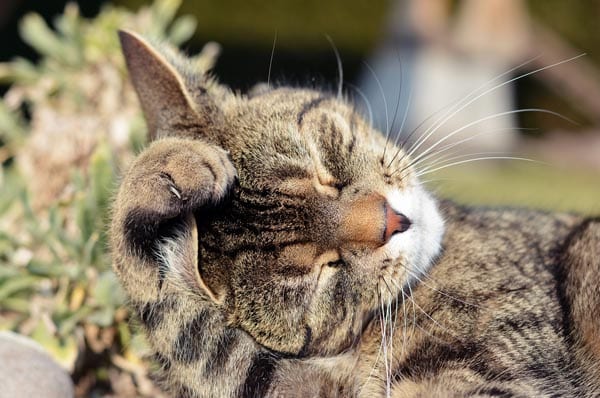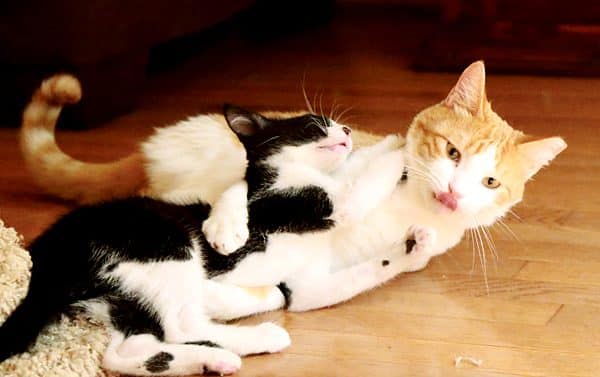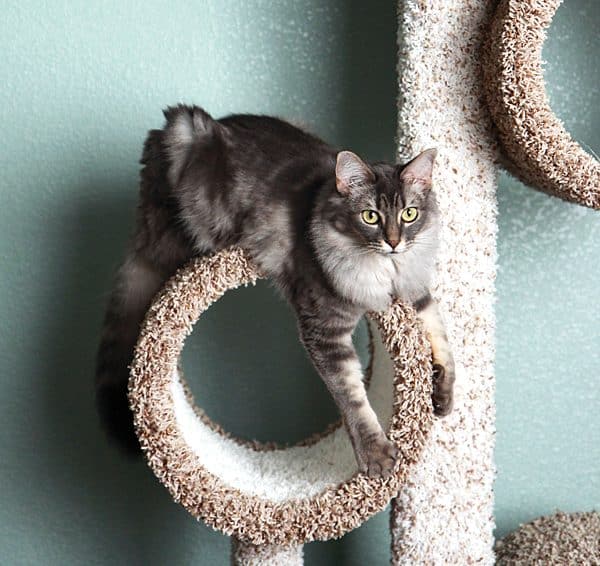Editor’s note: Have you seen the new Catster print magazine in stores? Or in the waiting area of your vet’s office? This article appeared in our November/December 2016 issue. Click here to subscribe to Catster and get the bimonthly magazine delivered to your home.
When we first adopted Jack, our red tabby, our lifestyle allowed us to be home with him every afternoon and evening. We lavished him with attention, engaged him in play with interactive toys, tossed lightweight balls down a short flight of stairs so he could bound down to retrieve them, and snuggled with him on the couch. Jack grew used to sleeping at the ends of our beds, changing his location based on his whims.
As my children grew older and participated in more extracurricular activities, and I took a full-time job with a long commute, we had less time to spend with Jack. He started scratching inappropriately and grooming himself much more, leading me to find an increased number of hairballs around the house.

It turned out that Jack (4 years old at the time) showed classic symptoms of boredom.
“Under-stimulated cats are at risk of developing boredom-related or stress-relieving behaviors, such as over-grooming, chewing inappropriate items, picking on companion pets, retreating into isolation, overeating, self-mutilation, compulsive behavior, and loss of appetite,” explained Pam Johnson-bennett, certified cat behaviorist and owner of Cat behavior Associates (cat behaviorassociates.com).
Pam said that cats are made to be active. There are so many facts about your cat’s body that enable her to have incredible speed, stealth, and accuracy, she said. “Imagine having all that equipment, and it never gets used. That’s the way it is for many cats.”
In Jack’s case, we added another cat to our household so he would have someone to run around with while we were away most of the day. “Having a buddy can make a huge difference when it comes to enriching a cat’s life,” Pam said. And Jack has benefitted greatly from his companionship with Phillip, who we adopted as a kitten.
Kittens
Phillip also benefitted from Jack’s companionship, as even kittens need environmental enrichment to be healthy and happy.
“You want to make sure that environment is filled with stimulation, fun, and security and comfort,” Pam said. She recommended socializing a kitten with a variety of people, sounds, and experiences to help the kitten handle changes and introductions to new people as she grows older.

Don’t worry: If your kitten is hesitant with new people or new situations, it’s likely because she is still getting used to everything, especially when you first bring her home. “Keep in mind that your home environment is unfamiliar and big,” Pam said. “That’s a lot for a little kitten to adjust to initially.”
Be concerned: If your kitten seems listless or completely uninterested in her surroundings, take her to the vet as soon as possible.
Adults
Life can seem infinitely interesting to a kitten who discovers new things all the time. Adult cats may soon run out of interesting things to investigate. And that’s when boredom can set in. Fortunately, there are many ways to make life interesting for your adult cat beyond adding a feline companion. Pam recommended regular interactive playtime, using toys that allow the cat to practice her instinctive hunting skills.

When you can’t be home to play with your cat, Pam suggested creating an interesting environment for your cat to explore, using cat trees, hideaways like teepee beds and boxes, and tunnels. “You can include food-related environmental enrichment whether you’re home or not through food-dispensing toys, aka puzzle feeders,” she added.
Don’t worry: Environmental enrichment for your cat does not have to involve expensive toys or equipment. Your cat will be just as happy with a cardboard box with holes cut in the sides as with a multi-level cat tree.
Be concerned: Try not to rely on external methods to keep your cat entertained. Your cat would love personal attention from you and other family members. Make time regularly to interact with your pet through playtime.
Seniors
Even seniors need environmental enrichment. “Even if your elderly cat is not so mobile, you can still engage him in low-intensity play sessions,” Pam said. “Any activity that causes him to have a little spark about life is beneficial.”
And while your senior cat may not be bored with his environment, he may begin to show signs of disorientation or cognitive dysfunction. Pam suggested small changes to help make your senior’s life comfortable and enjoyable, such as providing steps up to his favorite perching locations, adding litter boxes throughout the house to help prevent accidents, and grooming him regularly.

“Most of all, be patient and understanding,” she said. “These golden years can be absolutely precious and a time of tender closeness between the cat and his human family.”
Don’t worry: Your senior cat may not be as active as he once was, but this doesn’t mean he’s bored.
Be concerned: A change in your senior cat’s behavior can be a symptom of a medical condition. “Don’t assume it’s just normal age-related behavior without having him checked by the veterinarian,” Pam said. “If you’re alerted to these changes early, there are things you can do to make life more comfortable for your senior feline.”
About the author: A lifelong cat owner, Stacy N. Hackett writes about cats, cat breeds, and pet-related topics. A big source of inspiration comes from her two adopted cats: Jack, a 6-year-old red tabby domestic shorthair, and Phillip, a 2-year-old gray-and-white domestic shorthair. Stacy also is “stepmom” to a Cocker Spaniel/Labrador Retriever mix named Maggie as well as two brown tabbies named Katie and Leroy.







